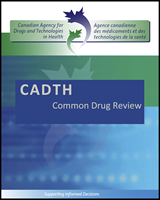| Drug Product | Ustekinumab (Stelara) |
|---|
| Study Question | The objective of the analysis was to assess the cost utility of ustekinumab in the treatment of moderate-to-severe Crohn’s disease (CD) in patients who have experienced a failure with conventional therapy only (FCTO), patients who have experienced a failure with anti–tumour necrosis factor (anti–TNF) biologics, and a mixed population of those who have experienced FCTO and failure with anti–TNF, compared with other biologics and with conventional therapy. |
|---|
| Type of Economic Evaluation | Cost-utility analysis (CUA) |
|---|
| Target Population | Adult patients with active CD (CDAI of ≥ 220 and ≤ 450), who have experienced either FCTO or failure with anti-TNF therapy |
|---|
| Treatment | Ustekinumab:
|
|---|
| Outcome | Quality-adjusted life-year (QALY) |
|---|
| Comparators |
Biologics: Infliximab (and infliximab biosimilar): 5 mg/kg and 10 mg/kg at 0, 2, and 6 weeks, and every 8 weeks thereafter Adalimumab: 160 mg at week 0 followed by 80 mg 2 weeks later, and then a maintenance dose of 40 mg every other week Vedolizumab: 300 mg at 0, 2, and 6 weeks, then every 8 weeks thereafter
Conventional therapies: Induction phase Oral steroid: a starting dose of 40 mg to 60 mg prednisolone daily, reduced by 5 mg per day at weekly intervals Oral azathioprine: 2 mg to 2.5 mg/kg/day
Maintenance phase
|
|---|
| Perspective | Canadian public health care payer |
|---|
| Time Horizon | 25 years |
|---|
| Results for Manufacturer Base Case |
|
|---|
| Key Limitations | CDR identified the following key limitations:
Uncertainty with the transition probabilities: Important limitations were identified with the data from NMAs (heterogeneity across studies, carry-over effects from the induction phase to the maintenance phase) used to populate the model transition probabilities for the induction and maintenance phases of treatment. CDR could not test this limitation with enough certainty because of a lack of evidence. Uncertainty of the clinical effectiveness of infliximab: Infliximab trials in patients with FCTO used a different definition of response, and data on patients with failure of anti-TNF therapy were not available, leading to the use of adalimumab data. This limits the cost-effectiveness assessment of infliximab. CDR could not test this limitation with enough certainty. Utility values for model health states: There is inconsistency in how utility values were used by the manufacturer. This raises uncertainty about the results of the analysis. CDR conducted two scenario analyses: (1) applying utility values to the model based on the published study used by the manufacturer with more consistency, and (2) using an alternative set of utility values used in previous CADTH models in Crohn’s disease. Modelling error for the ustekinumab mixed dosage (every 8 weeks/every 12 weeks) treatment option: The model incorrectly calculated the weighted average QALY results for the ustekinumab mixed dosage (every 8 weeks/every 12 weeks) treatment by excluding the QALYs of the every 12 weeks dosage, which overestimated the ICUR results for the ustekinumab mixed dosage (every 8 weeks/every 12 weeks) treatment option, considering only the favourable every 8 weeks QALY benefits. This was corrected by CDR. Adjustment of the maintenance-phase transition probabilities using real-world evidence: The manufacturer’s approach is highly uncertain and increased the effect of treatments, which favours ustekinumab. CDR reanalysis excluded the impact of real-world evidence on the transition probabilities.
|
|---|
| CDR Estimate(s) |
As described above, the health-state utility values and the effect of real-world evidence on the transition probabilities in the maintenance phase of the model were assessed in the CDR base case. CDR also corrected the error that overestimated the ICUR results for the mixed dosage. CDR base case for ustekinumab when compared with conventional therapy in the population with FCTO resulted in an ICUR of $115,474 per QALY gained and, in the population with failure of anti-TNF therapy, $131,297 per QALY gained. For the mixed population with FCTO and with failure of anti-TNF therapy, ustekinumab resulted in an ICUR of $119,058 per QALY when compared with conventional therapy. Among the available biologic therapies in patients with FCTO, ustekinumab every 12 weeks was the most cost-effective, with an ICUR of $115,474 per QALY, compared with conventional therapy, followed by ustekinumab mixed dosage every 8 weeks/every 12 weeks with an ICUR of $623,571 per QALY, when compared with ustekinumab every 12 weeks, then finally by ustekinumab every 8 weeks, with an ICUR of $658,533 per QALY compared with ustekinumab mixed dosage. Other biologics were either dominated or subjected to extended dominance. In the patients with failure of anti-TNF therapy, the most cost-effective treatment was biosimilar infliximab, with an ICUR of $90,277 per QALY compared with conventional therapy, followed by ustekinumab every 12 weeks, with an ICUR of $228,571 per QALY compared with biosimilar infliximab, with the remaining ustekinumab (every 8 weeks and mixed dosage) regimens resulting in ICURs of more than $1 million per QALY. Remaining biologic therapies (adalimumab, infliximab, and vedolizumab) were also dominated or subjected to extended dominance. Based on manufacturer correspondence indicating that the drug costs with the induction dose for ustekinumab would be reimbursed by the manufacturer, the ICURs for ustekinumab improve compared with conventional therapy and other biologic therapies, as expected. A driving limitation of the CUA was the uncertainty associated with the comparative efficacy and safety of ustekinumab versus other biologic therapies.
|
|---|

